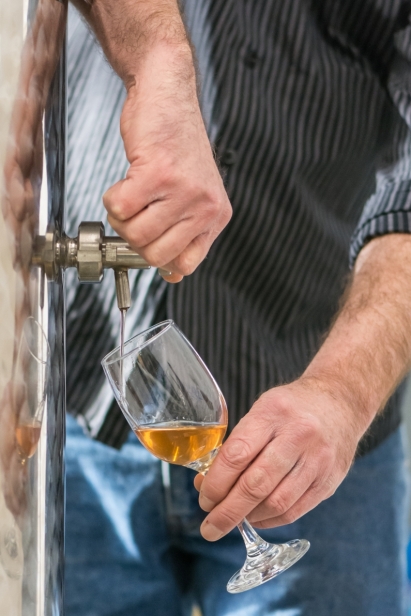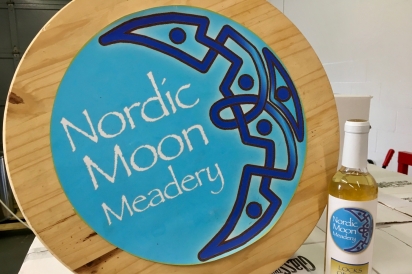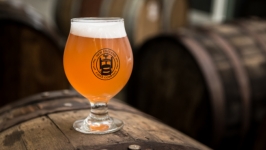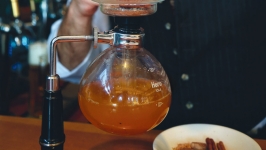Nordic Moon Meadery
Despite the lacking ubiquity of mead in the Nutmeg State, the fermented honey drink has a celebrated history in cultures across the world. “Almost every world culture has some version of mead, but there was really great, notable mead in Norse and Celtic cultures, as well as ancient African cultures,” says Richard Gummoe, co-partner at Ellington’s Nordic Moon Meadery.
Gummoe’s decade-long passion for home-brewing and distilling led him to open Connecticut Valley Distillery in 2009, but he ultimately wanted to expand beyond the distillery’s single line of rum. In 2015, along with partner Kevin West, Gummoe founded Nordic Moon Meadery, and the two spent more than a year researching and perfecting their mead recipe. This past February, they began self-distributing their mead for the first time and intend to expand to other retailers later this spring.
Mead is an alcoholic beverage which starts by fermenting honey with water. Often added to that are various fruits and spices and, in some cases, grains or hops. The variety of spices that can be added translate to a diversity of potential mead flavors, and cultures throughout history have concocted flavor varieties that are unique to their regions. Not all, however, would be found immediately palatable to our modern tastes. “I think that traditional, high-quality meads were very difficult to produce at that time,” Gummoe states.
Gummoe and primary mead-maker Kevin West have worked to translate this ancient libation into one that pleases present-day taste buds. “It really took a year to come up with a refined product,” Gummoe says. Despite years of home-brewing, making mead still presented challenges for Gummoe. Thankfully, a synergistic culture among brewers and other alcohol producers expedited the process. “Cider companies, sake producers, beer brewers…we’re all talking to each other, so we’re getting a valuable sharing of information. I did a lot of studying and meeting other brewers. Honey is just a totally different fermentable product, so it’s different than rums or whiskeys. There was definitely a learning curve.”
Sourcing local honey is a priority for Gummoe, but the meadery’s production requirements force him to look beyond Connecticut’s own apiaries. “Connecticut doesn’t make enough honey for us to use. I approached many of our local beekeepers and organizations, and Connecticut just doesn’t have enough. Some were pretty surprised when they heard how much we needed.” Indeed, Gummoe’s product has demanding requirements. “We use about 55 gallons of honey for each batch of mead,” he says, noting that he hopes growing interest in mead will encourage apiary growth in Connecticut.
In the meantime, importing honey from outside Connecticut does not translate to a sacrifice of quality or sustainability. West and Gummoe primarily use orange blossom honey, which they typically source from Florida or California, and they go out of their way to ensure it is both unadulterated and sustainably harvested. “We have taken the extra step to educate ourselves in honey. We buy ‘true source’ honey, which means that it can be tracked all the way from the hive to us. Not all mead people do that. Sometimes, they just don’t know what they’re buying.”
Well-sourced honey offers more than an inherent ethical value; it also has a powerful impact on the quality of mead that comes from it. “If you don’t know the source of your honey, the flavor profile can change and so can the process, acidity, and pH levels,” Gummoe says. Mead’s fermentation process is similar to that of both wine and beer in that the liquefied honey adopts a new flavor profile when yeast is added. The process itself has few steps but requires close attention and, often, repetitive tweaking. Yeast nutrients are added to reinforce growth, and within two to three months, Viking descendants (or any aspiring masters of the sea) are ready to clink glasses and say “skål!” to a drinkable mead. Although, Gummoe advises, it doesn’t hurt to let it rest for a while, as mead’s often cited similarities to wine don’t end just with its color or flavor: like many wines, the longer mead matures, the better it gets.
Although mead does not have as strong a Connecticut foothold as some other locally produced libations, Gummoe believes it is gaining traction. Hoppy beers remain extremely popular, but Gummoe believes that their abundance in our state’s craft brewing scene has left some drinkers’ taste preferences out in the cold. He is confident that many locally-minded drinkers will gravitate toward something unique and different, and it’s a niche that Nordic Moon Meadery is happy to fill.
Ready to try a glass? Visit Nordic Moon Meadery’s website for information about where to find a bottle or plan to drop in to their new tasting room when it opens in early June.
Nordic Moon Meadery: Ellington; 860-454-0026
Nordic Moon Meadery’s branding pays homage to Norse culture and tradition, which had a legendary reverence for mead. They currently produce four types:
Odin’s Eye
A straightforward mead that references a Norse myth about the god, Odin, who gouged out one of his eyes in exchange for immense wisdom.
Locks of Idunn
An intense ginger mead that alludes to the beautiful goddess with golden braids who guards the apples of youth.
Aphrodite’s Blush
A sweet, strawberry-flavored mead that honors Aphrodite, the Greek goddess of love.
Yggdrasil (Tree of Life)
A slightly bitter apple mead that adopts the name of a mythical tree rooted in Norse cosmology.














